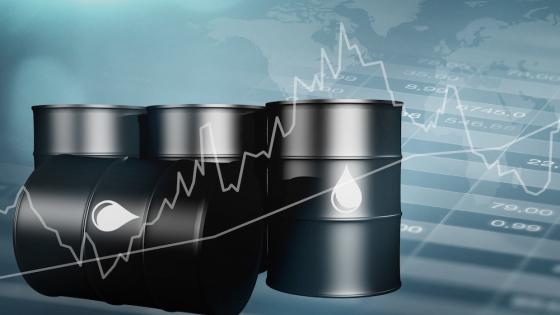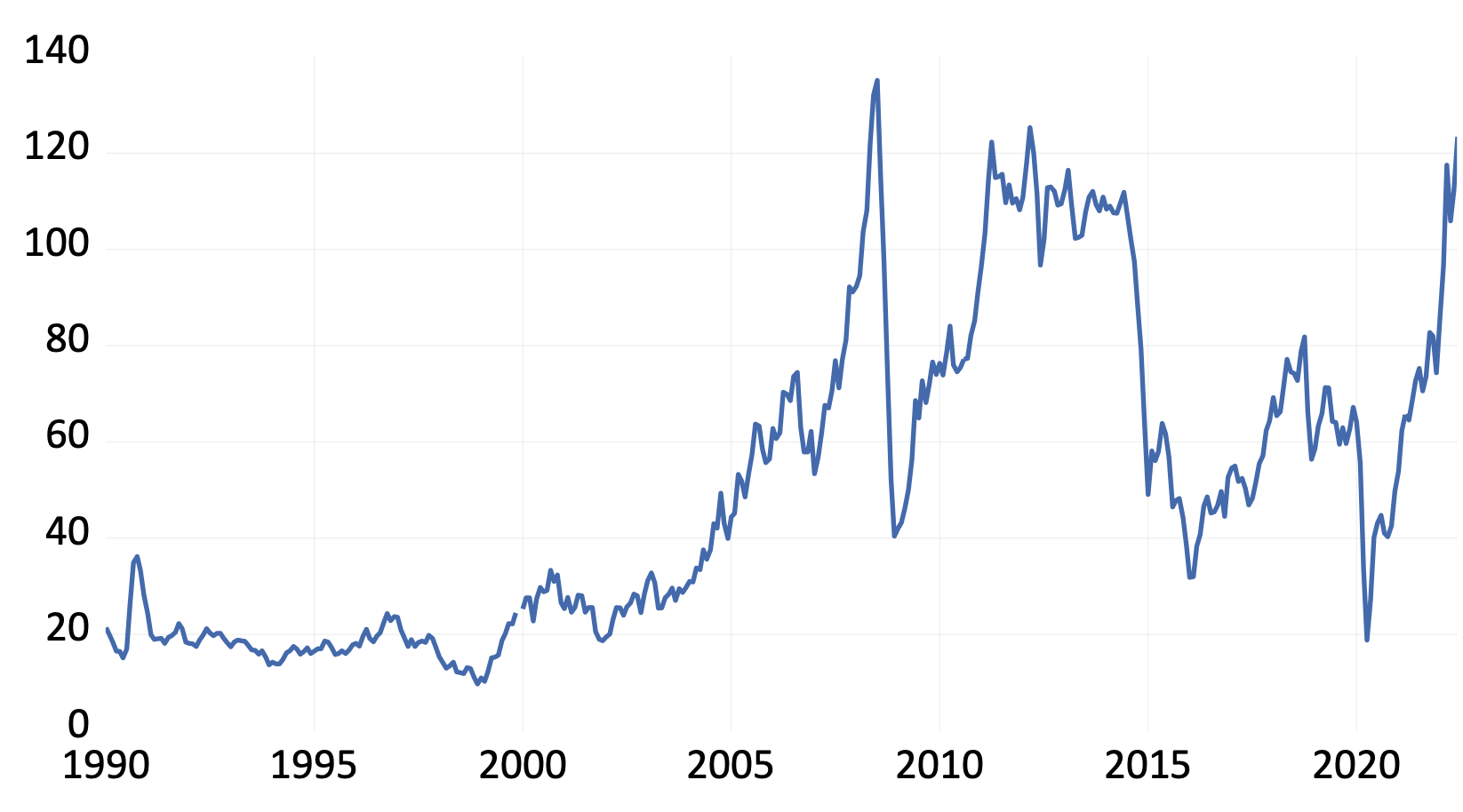The economic recovery following the gradual relaxation of public health restrictions imposed during the COVID-19 pandemic and the subsequent Russian aggression against Ukraine brought oil prices to extreme highs (see Figure 1) following the lows reached in early 2020.
Figure 1 Brent oil price in USD
Source: International Energy Agency.
A key question is why, given these high prices, oil supply has not reacted more strongly, providing downside pressure on prices. While it is true that Russian supply has been significantly curtailed due to sanctions imposed by Western countries (Kilian and Plante 2022), what about production by other key players such as Saudi Arabia – often considered the ‘central bank of the oil market’ (Nakov and Nuno 2013) – or the United States, the new ‘swing producer’ where shale oil production is considered to be very flexible?
Here, a host of possible reasons have been mentioned, including geopolitical reasons in Saudi Arabia and OPEC, and sluggish investment by US shale oil producers. More generally, it is also surmised that concerns about climate change policies could discourage investment by fossil fuel producers, further exacerbating demand-driven upward spikes in oil prices.
Identifying the supply of oil
To identify the supply function for oil, one needs to isolate sources of variation in demand that are orthogonal to supply, which is not straightforward. In a recent paper (Foroni and Stracca 2022), we apply instrumental variables to deal with the simultaneity between oil production and its price. In particular, we take a novel approach estimating exogenous demand shocks using a monthly SVAR of the global oil market similar to Kilian and Murphy (2014). We then use these demand shocks to identify movements in the real price of oil driven by factors exogenous to supply. Together, these shocks allow us to uncover the underlying oil supply function.
A further novelty of our approach is the flexible estimation of demand shocks using rolling samples. This allows for potential time variation in the elasticity of oil supply around the time of the shale oil revolution in the US. We estimate the oil supply curve using local projections, in rolling samples of ten years, using the demand shocks estimated in the rolling samples as instruments. We are particularly interested in the question of whether the boom in US shale oil production since 2010 has fundamentally changed the contours of global oil supply.
The main conclusion of our analysis is that the global oil supply curve is – and has remained – rather ‘vertical’ (i.e. less price responsive), with a short-term elasticity of around 0.05. Our rolling sample estimations reveal that the shale oil boom does not appear to have fundamentally changed the contours of global oil production (see also Kilian 2017 and Mathieu et al. 2014), but there is evidence to suggest that the oil supply curve is more ‘vertical’ in Saudi Arabia and more ‘horizontal’ (i.e. more price responsive) in the US since 2010, in particular for shale oil.
Whose supply has been missing in 2021–22?
Armed with these time-varying oil supply elasticities, we then turn to the following question: has oil supply behaved in line with empirical regularities in 2021–2022, even in the face of relaxing public health restrictions and the war in Ukraine? Here we proceed in three steps.
First, we estimate oil supply curves for Saudi Arabia, Russia, the US (total and shale), and the world using monthly data from 2011-2020. In line with Foroni and Stracca (2022), these estimates confirm that the price elasticity is low for Saudi Arabia, high for the US (particularly for shale oil), and intermediate for world supply and Russia.
Second, we regress changes in oil prices on demand shocks estimated with a time-varying version of the model in Kilian and Murphy (2014) in 2021–2022. This gives us an estimate of movements in the price of oil that have been driven by demand over the past two years.
Third, we take oil supply elasticities estimated up to 2020 and project oil production in 2021–22 based on demand-driven oil price changes obtained in the second step. This tells us what oil production would have done had the main producers reacted in the same way in 2021–22 as in the previous decade.
The main results of this exercise are shown in Figure 2. The blue dashed lines in each panel plot actual oil production while the solid red lines plot projections based on estimated oil supply elasticities and demand-driven changes in oil prices. Overall, there is a clear shortfall in world oil production, in particular in 2022 (upper-left panel). What drives this shortfall? As shown in the middle-left panel, production in Saudi Arabia – the ‘central bank of the oil market’ – has actually exceeded the projection, mostly on account of the fact that the estimated price elasticity is very low as seen by the very flat red line. The shortfall is rather driven mainly by (1) Russian production, in particular in 2022 on account of the invasion of Ukraine and the related sanctions; and (2) US shale oil, which is significantly below the projection in 2021-22.
This in turn sheds further doubt on the nature of US shale oil as the world’s ‘swing producer’, at least for the time being.
Figure 2 Oil production actual vs projected
Note: Data in thousands of barrels per day. The blue dashed lines refer to actual oil production (Source: International Energy Agency), the red lines to projections based on (i) estimated oil price elasticity in 2011-2020 and (ii) oil prices changes in 2021-22 driven by demand shocks according to a time-varying version of the Kilian and Murphy (2014) model. See Foroni and Stracca (2022) for further details.
Conclusions
In this column we have used time-varying estimates of oil supply elasticities from Foroni and Stracca (2022) to shed light on the question of whether global oil supply is underperforming, which in turn has kept prices high. We conclude that there is a shortfall of global oil supply that is concentrated mainly in Russia in 2022 and in US shale oil in 2021. Time will tell whether persistently high oil prices will cause a sharp increase in shale oil production and whether financing constraints or concerns about climate change policies are important drivers of stagnating shale oil output. In any case, oil prices and oil production are only part of a bigger discussion on energy that should be seen from a holistic perspective (Arezki and Paduano 2022).
Author’s note: The views expressed belong to the authors and are not necessarily shared by the ECB. We thank Christofer Schroeder and David Lodge for useful comments.
References
Arezki, R and S Paduano (2022), “The energy balancing act between security and transition”, VoxEU.org, 1 July.
Foroni, C and L Stracca (2022), “Much ado about nothing? The shale oil revolution and the global supply curve”, Journal of Applied Econometrics, forthcoming.
Kilian, L and D P Murphy (2014), “The Role of Inventories and Speculative Trading in the Global Market for Crude Oil”, Journal of Applied Econometrics 29(3): 454–478.
Kilian, L (2017), “Global repercussions of the US tight oil boom”, VoxEU.org, 2 April.
Kilian, L and M D Plante (2022), “The Russian Oil Supply Shock of 2022”, Federal Reserve Bank of Dallas.
Mathieu, M, T Spencer and O Sartor (2014), “Economic analysis of the US unconventional oil and gas revolution”, VoxEU.org, 22 March.
Nakov, A and G Nuño (2013), “Saudi Arabia and the oil market”, Economic Journal 123(573): 1333–1362.





